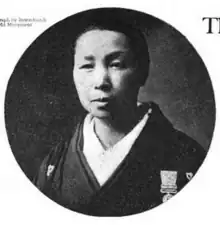
Yone Suzuki (鈴木よね, 1852.8.15–1938.5.6) was a Japanese businesswoman, described in 1918 as "the wealthiest woman in Japan".
Early life
Career
As a widow with two sons, Yone Suzuki took over her late husband's business, the Suzuki Trading Company (Suzuki Shoten), trusting manager Kaneko Naokichi with many of the strategic decisions.[2][3] In 1900, she made a fortune in a deal involving sugar, real estate, and camphor. She started a peppermint factory, she bought the Kobe Steel Works, and expanded her operations in camphor manufacture, sugar refineries and flour mills. She built a factories to produce fish oil and bean oil, owned a fleet of ships,[4] and added branch offices of the Suzuki conglomerate in several international locations, including Europe, North America, Australia, and elsewhere in Asia.[5]

She was described in 1918 as "the wealthiest woman in Japan",[6] and in 1927 as the "richest woman in the world."[7] However, she was also described as "one of the best-hated persons in the country" for taking advantage of wartime conditions and for running up the price of rice.[8] She had to go into hiding with an alias for a while during the rice riots of 1918, after angry crowds burned her company's headquarters in Kobe.[8]
The Suzuki conglomerate was badly affected by a foreign exchange crisis in 1923–1924, and finally failed in a financial panic in 1927.[9] The 1923 Great Kantō earthquake, dysfunctional internal dynamics, unpopular business practices,[10] and external rivalries with other large Japanese conglomerates (zaibatsu), are also cited as contributing to the Suzuki collapse.[11] Among the present-day companies descended from Suzuki & Co. are Kobe Steel ,Sojitz,J-oilmils(Honen Corporation).[12][2]
Personal life and legacy
She married Iwajiro Suzuki, a sugar merchant, when she was 13 years old. Their sons were Iwajiro and Ewazo.[13] She was widowed when he died in 1894.[7] At the peak of her wealth, she lived in a mansion at Suma-ku, Kobe; she moved into more frugal conditions after the collapse of Suzuki & Co.[14]
The 2014 Japanese television drama Oiesan was a historical drama based on a novel by Kaoru Tamaoka about Yone Suzuki's life. Yūki Amami played Yone Suzuki in the program.[15]
References
- ↑ "Japan's Richest Woman" Boston Daily Globe (August 8, 1920): 54.
- 1 2 "Suzuki & Co. Ltd." The Sojitz History Museum.
- ↑ Yoshio Katsura, "The Role of One Sogosha in Japanese Industrialization: Suzuki & Co., 1877–1927", a paper presented at the Business History Conference, Nishinomiya, Japan (November 18–19, 1972).
- ↑ "Japan's Ship Mistress" The Nautical Gazette (November 13, 1920): 21.
- ↑ "The World's Greatest Women: Mrs. Yone Suzuki, Business Woman" Green Book Magazine (December 1919): 13.
- ↑ Elsie F. Weil, "A Little Woman of Big Enterprises" World Outlook (September 1918): 10.
- 1 2 "Richest Woman in the World; Wonder Widow of Japan" Canberra Times (June 14, 1927): 5. via Trove

- 1 2 "Japanese Mob Widow" Washington Post (December 8, 1918): E3.
- ↑ "Japanese Morgan" Time Magazine (April 18, 1927).
- ↑ "Japanese Profiteer" Ashburton Guardian (January 3, 1919): 3.
- ↑ L. H. Lynn and H. Rao, "Failure of Intermediate Forms: A Study of the Suzuki zaibatsu" Organization Studies 16(1)(1995): 55–80.
- ↑ Stuart. D. B. Picken, Historical Dictionary of Japanese Business (Rowman & Littlefield 2016): 393. ISBN 9781442255890
- ↑ Lester Lear, "A Woman Tramples Tradition to Make Her People Great!" Brooklyn Daily Eagle (June 10, 1923): 9. via Newspapers.com

- ↑ "Once Richest Woman Now Living Frugally" Washington Post (April 24, 1927): 3.
- ↑ "Oiesan" (2014), at Internet Movie Database.